Weird of Oz Revisits Fighting Fantasy
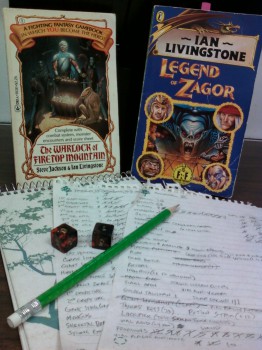 Rogue Blades Entertainment continues to put out fine new projects — though, I lament, with far less frequency than in days of yore.
Rogue Blades Entertainment continues to put out fine new projects — though, I lament, with far less frequency than in days of yore.
Also in those days of yore (about two years ago, to be precise), for a brief, shining, halcyon period of time (a few months, to be precise), RBE hosted a website that ran regular blogs under the banner “Home of Heroics.” It was my good fortune to be invited into HoH’s stable of bloggers, and I made a couple contributions before that heroism-vaunting home vanished like the fabled city of Xanadu. I only got in two or three posts, mind you, because I was on a monthly rotation rather than the weekly slot I enjoy here on Black Gate.
One of those posts that I wanted eventually to follow up on was an account of my experience revisiting Fighting Fantasy gamebooks. My report touched off similar nostalgic reminiscences from several readers.
Since, as far as I can tell, the material that ran on HoH is no longer accessible, I’d like to use this St. Patrick’s Day edition of Weird of Oz to resurrect that post here — with an eye to reviewing other single-player gamebooks down the road.
Zagor will Feast on Your Nostalgia!
So maybe it’s because I’m a fairly new daddy, or maybe it has something to do with hitting the big Four Oh — mid-life crisis and all that — but lately I’ve had a touch of nostalgia. Or, to be frank, nostalgia has mercilessly grabbed me and throttled me into submission. Now, Lord help me, I find myself hunting down stuff I threw out with sheer indifference decades ago.
Exhibit A:
The top of my office bookshelf is now lined with ‘80s D&D action figures — just like the ones I had when my age was still a single digit, ones I’d tossed soon after I hit two digits and was too old to play with toys…
Exhibit B:
I dug out the old Nintendo 64 and plugged in Gauntlet: Legends. Defeated Skorne and freed the Realm single-handed; barely broke a sweat. And for you young whippersnappers who think the N64 is about as ancient as an abacus, get this: Now I’m wistfully wishing I had an Atari 2600, so I could fire me up some Defender. Used to play that for hours, back when life was so much less complicated. Back when, you know, the most pressing concern on my mind was whether I could get away with sneaking a third one of Nan’s cinnamon rolls.
Exhibit C:
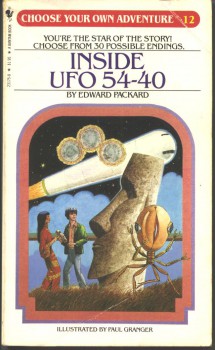 I came across a used copy of an old Fighting Fantasy paperback, which immediately stirred up long dormant memories of playing one or two of them back around the time when Hulk Hogan and Mr. T were the hottest tag team in the WWF (it wasn’t just entertainment; it was a Federation!) and Cyndi Lauper was their manager(!). These were books I’d just about forgotten existed, and had long outgrown, except… except nostalgia snuck up behind me, clubbed me over the head, and pulled out my wallet.
I came across a used copy of an old Fighting Fantasy paperback, which immediately stirred up long dormant memories of playing one or two of them back around the time when Hulk Hogan and Mr. T were the hottest tag team in the WWF (it wasn’t just entertainment; it was a Federation!) and Cyndi Lauper was their manager(!). These were books I’d just about forgotten existed, and had long outgrown, except… except nostalgia snuck up behind me, clubbed me over the head, and pulled out my wallet.
Having bought it, I soon became curious whether it would hold up nearly thirty years later — whether it would still deliver the kind of diverting fun that I dimly remembered. So I grabbed a couple six-sided dice, a pencil, and some paper, and I proceeded to find out.
Turns out the book I’d bought was the very first one in the series, The Warlock of Firetop Mountain (“A FIGHTING FANTASY GAMEBOOK IN WHICH YOU BECOME THE HERO!”) by Steve Jackson and Ian Livingstone. Originally published in Great Britain in 1982, this was the Dell 1983 American edition.
The idea of Fighting Fantasy was a sort of cross between Dungeons & Dragons and Choose Your Own Adventure, creating a solo adventure experience for young role-players everywhere to waste time during recess or study hall when a group of friends were not available. The series would go on for nearly sixty books, although by the ‘90s it had been pretty well eclipsed (and rendered all-but-obsolete) by computer games.
As soon as I decided to write down some thoughts about playing FF again, I figured I should also sample a later book to see how the series had evolved. It was interesting to compare the two — even moreso than I anticipated, as you will see.
Before Charlie Sheen, There Was the Warlock of Firetop Mountain…
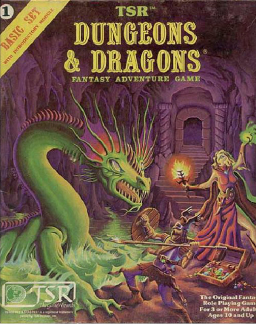 The first book was incredibly easy. Since it was a new system, I think the authors erred on the side of helping the player along (the “nice” DM scenario). My champion’s stats weren’t bad (I maxed my roll on Luck Points, which was huge), and the authors seem intent on re-upping depleted stats quite regularly (over time, as the system got play-tested by millions of people worldwide, this definitely changed—see my comments on book 54 below). I made it all the way through the dungeon and defeated the Warlock on my very first run-through, emerging victorious with barely a scratch.
The first book was incredibly easy. Since it was a new system, I think the authors erred on the side of helping the player along (the “nice” DM scenario). My champion’s stats weren’t bad (I maxed my roll on Luck Points, which was huge), and the authors seem intent on re-upping depleted stats quite regularly (over time, as the system got play-tested by millions of people worldwide, this definitely changed—see my comments on book 54 below). I made it all the way through the dungeon and defeated the Warlock on my very first run-through, emerging victorious with barely a scratch.
I can’t actually say I won, though. You see, once you defeat the Warlock, you have to claim his treasure (the hack-‘n-slash motive for most old-school adventures). To do this, you need to have collected all three keys to open his chest. I’d stumbled onto the route to the Warlock’s lair too quickly; I only had two keys. Ruh-roh. The final entry informed me of my character sitting despondently on the chest, devastated by the realization he would have to go back to the very beginning and complete the adventure all over again. Huh? I know they set it up this way to encourage repeat playing, but there’s a scenario short on internal logic. I just deposed the most powerful cat in this joint; all I have to do is go back and find that one key in some room I bypassed. I’m not gonna go back, Jack, all the way to the beginning and do it all over again. No, I win. (Really, it was just this: The book was mildly entertaining, but not enough so to play the whole thing over again.)
Dungeon Ecology, and Other Oxymorons
A word about ecosystems in these old-school fantasy games: there are none. Pretty funny, these dungeons.
You run into this sort of thing with old D&D adventures too: Why are a couple dwarfs living in a room down the hall from a barracks full of orcs, their sworn enemies? And around the corner there’s a giant who’s made his home adjacent to a den of dire wolves, in the shadow of a wyvern eyrie. Then some gibbering mouthers move in and there goes the neighborhood. If I were the dwarfs, I’d pack up and move somewhere where everyone at the block party doesn’t want to eat me. The menagerie of mythical creatures who reside inside the twisting passages of Firetop Mountain is just as baffling. It makes for fun unpredictability when you open a door, but does not encourage any reflection on world-building or deeper story implications.
Anyway, having defeated the warlock and his minions, I moved on to the other FF book I’d procured. Coincidentally, it happened to be book 54, which brings the Warlock of Firetop Mountain back (he has a name now: Zagor), this time as an undead half-demon sucked into another world where you are an adventurer who must fight him there. Onto Legend of Zagor, penned solo by Ian Livingstone…
Livingstone, I Presume?
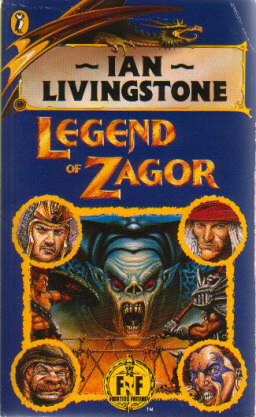 …or maybe it could be more aptly titled Zagor’s Revenge. After kicking his butt handily in book one, I was going to get to take on old Wardilocks again, on a new battleground. Oh, but boy have things changed. I soon learned that, eleven years and 53 books later, this Fighting Fantasy system went from a cakewalk to a hand-you-your-ass-after-ten-pages exercise in futility. Somewhere along the line, Livingstone must’ve grown a little sadistic, because the weakest monster encounters in this book are about on par with the final battle with the Warlock in Book One, although your character in this new adventure does not have commensurately better stats! And I don’t know how you could even hope to defeat some of the final monsters or Zagor himself without “cheating” and powering-up your own character (but I don’t know; I had to peek ahead because I never even got that far, though I tried. Again. And again. And again).
…or maybe it could be more aptly titled Zagor’s Revenge. After kicking his butt handily in book one, I was going to get to take on old Wardilocks again, on a new battleground. Oh, but boy have things changed. I soon learned that, eleven years and 53 books later, this Fighting Fantasy system went from a cakewalk to a hand-you-your-ass-after-ten-pages exercise in futility. Somewhere along the line, Livingstone must’ve grown a little sadistic, because the weakest monster encounters in this book are about on par with the final battle with the Warlock in Book One, although your character in this new adventure does not have commensurately better stats! And I don’t know how you could even hope to defeat some of the final monsters or Zagor himself without “cheating” and powering-up your own character (but I don’t know; I had to peek ahead because I never even got that far, though I tried. Again. And again. And again).
One other change with this installment is that you are given the option of four different characters — Anvar the Barbarian, Braxus the Warrior, Stubble the Dwarf, or Sallazar the Wizard. On a whim, I decided to go short and rolled up a Stubble. I hadn’t gotten more than a few rooms into Castle Argent before all that was left of me was a little bit of stubble. Game Over.
Rolled up a wizard next. “This may be fun,” I thought, oh so naively. “I get to cast spells.” Indeed, the wizard gets a neat little spell list, but he is supplied with only enough magic points to use them a few times before he is just a weak human engaging in hand-to-hand combat (and without the benefit of armor or better weapons like the other characters!). My wizard didn’t get much farther than the dwarf before he was reduced to a stain on the floor (which might or might not exude a slightly magical aura). Game Over.
Okay, obviously what’s called for here is a brutish, brawny, big gun. Time for the Barbarian. Heh. Did not get past the very first encounter.
Fourth time’s a charm, maybe? So annoyed that I’d generated a character that didn’t last five minutes, I just re-used my barbarian’s stats and christened him Anvar II. This time around, I did manage to get well into the second level of the castle. Twice I was reduced to one stamina point, but somehow managed to survive, only delaying the inevitable. Before long he shared the fate of his precursors.
Castle Argent: Like Being Stuck in Groundhog Day, Except at the End of Each Day You Die
Frankly, I really didn’t feel like going through all that a fifth time. So if you want to know how it ends, you’ll have to play it yourself. Just take my advice on this: If you don’t want to waste your time playing the same encounters over and over with the same grisly results, don’t bother rolling your stats. Just max them up. Take 24 Stamina Points and as many Skill, Luck, and Magic Points as your character type allows (If you play the Wizard, why don’t you double that last stat? Take 14 Magic Points — c’mon, you’re a wizard taking on the most powerful demon-lord in the realm for god’s sake! If you get any complaints, tell ‘em I said you could). Trust me, even maxed-out, your character will find this adventure challenging, and he’ll still probably die.
The introduction claims that “any player, no matter how weak his or her initial dice rolls, should be able to struggle through to glory in the end.” The introduction lies. More like: Even if you have pretty good initial dice rolls, you will probably struggle through only a few pages before coming to a gory end.
From what I’ve since gathered online, not all the later books are this difficult for the player to crack, and maybe they are not so obsolete after all—Wizards of the Coast has re-launched the series, and some are now available for e-readers. Fighting Fantasy has also made the jump to new platforms: under the supervision of Jackson and Livingstone, a company called Big Blue Bubble has adapted Warlock into Nintendo DS and iPhone/iPad 3D RPGs.
Pretty Pictures of Nasty Creeps
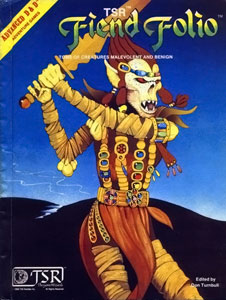 Finally, a word on the illustrations—Russ Nicholson’s black-and-white line art really brings the dungeon denizens and their environs to life far beyond any descriptive passages. Michael Tresca, RPG reporter for the online Examiner, informs me that Nicholson was also the main illustrator for the original Fiend Folio. Martin McKenna’s illustrations for Legend of Zagor also far surpass their source material. The profuse, evocative (and sometimes quite creepy) illustrations make both books great fun to flip through.
Finally, a word on the illustrations—Russ Nicholson’s black-and-white line art really brings the dungeon denizens and their environs to life far beyond any descriptive passages. Michael Tresca, RPG reporter for the online Examiner, informs me that Nicholson was also the main illustrator for the original Fiend Folio. Martin McKenna’s illustrations for Legend of Zagor also far surpass their source material. The profuse, evocative (and sometimes quite creepy) illustrations make both books great fun to flip through.
Concluding Remarks, Which You can Read Even if You Did Not Find All Three Keys
All in all, Fighting Fantasy did prove to be the sort of entertaining if mindless diversion I remembered. There was another series I played as a youngster that took the whole concept to another level: The Lone Wolf books, which had a more consistent premise and secondary world, and featured a character that you continued playing throughout the series. He increased in skill and power, his achievements carrying over from book to book. Maybe I’ll revisit those for a future column.
Good comments. I was pretty fanatical about FF books back in the 1980’s. D&D and stuff like that was still pretty new so even though I was 15 or so and the bookes were likley aimed at a slightly younger audience, I lapped them up.
Agree re Warlock on Firetop Mountain. I got it later on and had already tackled The City of Thieves, Masks of Mayhem, the impossible (if you are bad at maths like me) Rebel Planet and the incredibly difficlt Creature of Havoc, which was finally rendered simpler by fixing the type on a go to page ref (one wonders if that was deliberate:). So yes Warlock was a bit simplistic and easy by comparison.
I held onto my collection, which my younger brother took over and added to and more recently which i have fleshed out here and there from flea market finds and the like. Tried to get my son interested and while he was keen, the interest waned. I suppose Play Station is more fun…
Favourite book of the series, hmm, hard to tell. Island of the Lizard King i guess, but thats just because i like Lizard Men, actually liked them thanks to FF books, they were always drawn so cool.
Interestingly, I always perceived that a few of the Ian Livingstone books followed on – in the original 80’s chronology:
Warlock on Firetop Mountain (with Steve Jackson who is not Steve Jackson of Steve Jackson games) ==> Forest of Doom ==> City of Thieves ==> Deathtrap Dungeon ==> Island of the Lizard King ==> Caverns of the Snow Witch ==> Temple of Terror.
Thereafter it gets a bity hazy but its possible Deamons of the Deep and Trial of Champions may also have been included.
Note 1), EBOOK VERSIONs: Select Fighting Fantasy (like Warlock of Firetop Mountain) are now available on Kindle and iTunes (the Kindle versions are less sexy but work better, having provided a more robust game mechanic that includes superior mapping and dice roller systems). But…these are difficult. Even with a few savepoints…these are tough! Can you can’t cheat a video game by flipping back to passages in which you were alive!
Note 2) YOU ARE THE HERO: A ‘coffee table’ Book: Jonathan Green, author of many novels including those under the Warhammer and Fighting Fantasy brands, is now on a mission to create a history book detailing how the adventure books evolved; this book will celebrate 30 years of Fighting Fantasy (2012 marked 30yrs since “Warlock” was published), the publishing phenomenon created by Steve Jackson and Ian Livingstone.
Tiberius, by chance did you ever play any of the books from other companies, like Lone Wolf or the D&D series? I’ve been interested in checking some of the competing systems out, and would welcome thoughts/comparisons from anyone out there who has played them (and any recommendations).
SE Lindberg: Thanks for the updated info on eBook versions.
Re: Note 2), I’ve been amazed at the scarcity of historical or scholarly work on the whole RPG phenomenon of the past 40 years. The only book I am aware of that even begins to offer a comprehensive historical overview is Michael J. Tresca’s THE EVOLUTION OF FANTASY ROLE-PLAYING GAMES (2011).
This dearth is mind-boggling to me. Popular-culture-studies scholars, at the very least, should be ALL OVER this, considering the embrace, not just by a small cult following (although that is how it has sometimes been portrayed in the media), but by millions of players all over the world. And then you consider the direct evolution into the most popular computer/internet games played by hundreds of millions, and the subsequent influence on popular film etc…
People really should start recording this, getting it all down, keeping track of the connections, the branches of influence, the steps of innovation–because the whole RPG (leading into the video-game) phenomenon is likely as significant a development in story-telling in the late 20th century as the rise of the novel was in the early 18th.
Oz. There were a number of series published. I think the brief period where these books were a phenomenon caused many a children’s publisher to jump on the band wagon. Speaking from a South African perspective we saw mostly books from the UK, so for sure I may well not have covered a few series from USA etc. Here goes:
– Fighting Fantasy has been covered but I can add that the core system varied quite a bit. Per example book 2 The Citadel of Chaos introduced magic use so the system had to accommodate spell casting. There were natural deviations for the various SF (and one superhero) books. These could be vastly different (book 4 Starship Traveler) or pretty similar but with small changes (book 22 Robot Commando, where there were rules for piloting your mech). Some other neat changes were per example Armies of Death which allowed you to command troops.
– Sorcery was a spin off from FF, 4 books that followed on from each other written by Steve Jackson. There was a spell book as well although I have never seen a copy.
– Two player FF was a one off, 2 books that could be played stand alone or at same time to get a kind of tag team feel.
– FF also had its own RPG. They later on released Advanced FF RPG.
– Cretin Chronicles was also publsihed by puffin. Different system which is more complex. I actually located and bought the 3 books on eBay but have yet to work through them.
– Puffin also has a short lives Robin Hood series. (2 books I think). My brother had the first one but as I recall was not very impressed with it.
– The biggest challenger to FF was Lone Wolf, which still has a cult following and I think Mongoose Publishing is still adding to. System wise it was comparible with FF and as it was an ongoing series, I think it was probably overall a bit more cohesive.
– Way of the tiger was a series of 6 ninja styled books. Never played them but my brother rated them. The authors actually contributed 2 FF books (Talisman of Death and Sword of the Samurai).
– Blood sword was another series my brother rated. I think it was by same authors as Way of the Tiger. The books followed on and allowed for a party, so one reader could have a few players or could be the reader for a group of players. Pretty innovative!
– Saggard the barbarian was a less successful series. The system involved a diceless page flipping scenario where each page had a number in top corner and that would have something to do with the result.
– Skyfall by David Trant (sp) was published by armada books. Differently written and using a coin toss system, I recall enjoying the first 2. Think the series petered out after about 4 books.
– Then there was Proteus magazine. That was cool and pretty similar to FF system. It stopped after 18 or so issues, but a web search will locate a page where someone has scanned the mags in.
– There was also a very cool system/series by Pan Books, using large format (black gate magazine sized) books and a huge scope of options that would take one across books. I just wish I could remember its name!
– ICE also published a short lived MERP series. I recall having The Mines of Moria. Apparently due to legalities many of these were destroyed and are now collectible?
– Another series of Real Life Gamebooks also did the rounds. This was based on historic events, Minutemen and Militia, Cavaliers and Round heads etc. Not sure what the system was like.
– There was also Grail Quest series, although I have never seen it.
– More recently I think the Beast Quest line of children’s books have spawned an adventure book series, but think its more “choose your own adventure” orientated than “gamebook” although there is a bit of a fine line between the two concepts I think.
As a parting note back in 1988 I bethought to write my own FF book. I dutifully banged out a pretty awful (in retrospect) adventure on my moms typewriter occasionally using a dictionary to spell check but undoubtedly leaving in numerous typos, spelling and grammatical errors. I still have the manuscript and a polite rejection letter from Mark Gascoine.
I remembered the name of the pan books series – Fabled Lands.
Sagard “diceless?” Au contraire http://www.advanceddungeonsandparenting.com/2011/02/adventure-gamebooks-as-rpgs-part-2.html
TSR also had Super Endless Quest books that were Fantasy Game books.
I particularly enjoyed their 1 on 1 gamebook series. The Fafhrd and Grey Mouser one is among my favorites.
Re Saggard. Noted my mistake. Worked from a 27 year old memory based on a friend who had one of the books comments:) I do recall little numbered circles top right of each page. Perhaps that was an alternative to rolling a d4 – which tthe average punter likely wouldn’t have had handy. Actually I think I saw another series (could have been lone wolf) which has a page of random numbers so if you didn’t have a dice you could close eyes and randomly point to one.
Tiberius, That is a pretty thorough list –thanks!
Christian, There was one in which you played Fafhrd and Grey Mouser? I’ve got to get my hands on that one!
Tiberious, If my memory serves me correctly, it was indeed the Lone Wolf series that had the page of random numbers. You’d close your eyes and stick your pencil-tip down onto the grid. I always opted for dice (though I thought, rather amusingly, that a player could with practice develop a muscle-memory sense of where the best number was on the grid and learn to bring the pencil down consistently on that spot with eyes closed).
[…] gamer-geek hat still squarely donned following last week’s review of Fighting Fantasy gamebooks, today I want to chat about hit points. First off, I think […]
[…] Weird of Oz revisits Fighting Fantasy […]
[…] long ago, Black Gate’s redoubtable Nick Ozment looked at The Warlock of Firetop Mountain and several other of the Fighting Fantasy gamebooks. Nick remembered playing other Fighting Fantasy books, but not this one specifically. My experience […]